360° feedback :
Listening and evaluation in the workplace
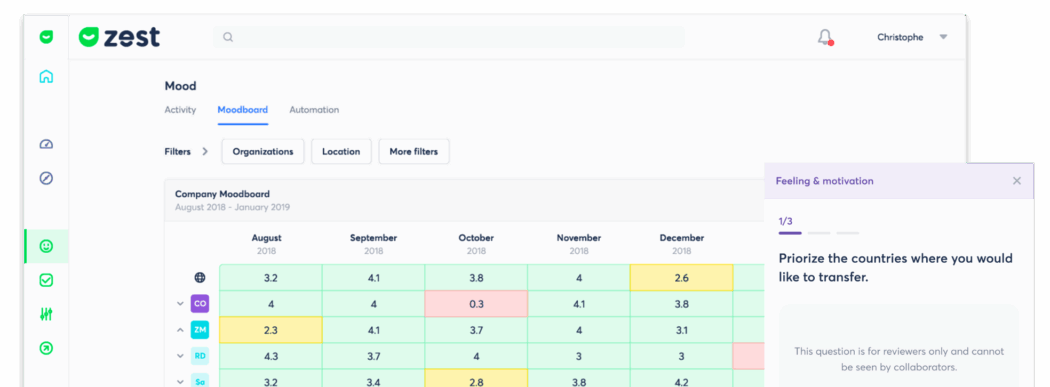
Feedback and feedback culture: definition
360° feedback : what is it ?
Historically, feedback traces back to two main streams. the first emerged from the human relations movement initiated by kurt lewin and his colleagues (group dynamics) around 1938–1939. the second, more recent, grew out of north american psychosociology’s focus on studying attitudes (aebischer & oberlé, 2007).
Introduced in the 1940s within the aerospace engineering field, feedback can be translated as “rétroaction.”
More literally, it signifies an “information loop that nourishes” dialogue between managers and their teams.
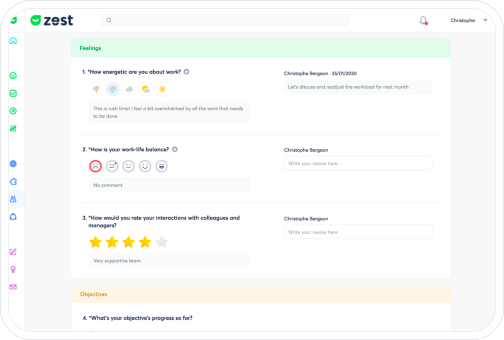
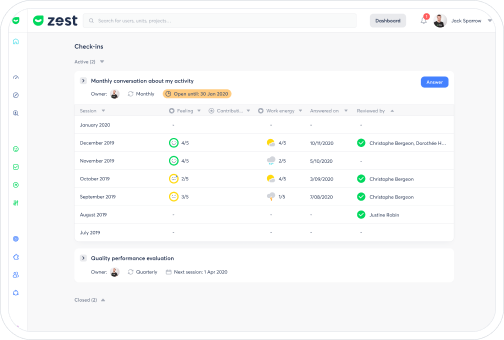
What are the key feedback techniques?
You’ll find three key feedback techniques in the workplace:
- Corrective feedback : realigns an employee’s work focus or behavior through constructive critique
- Positive feedback : acknowledges desired actions or attitudes, acting as a powerful motivator and confidence booster
- Negative feedback : delivered with care to pinpoint areas for improvement and drive personal development
What’s the principle behind a 360° evaluation?

Feedback
Feedback involves providing a team with input on actions taken, emphasizing efforts made over a given period, and/or attitudes to improve or correct.
Objective: continuous improvement of work and better attainment of defined goals, grounded in factual and legitimate feedback.

Feedback culture
Feedback culture, meanwhile, serves as both an individual and collective development tool and a performance booster. In short, it’s about fostering regular dialogue between managers, employees, teammates, and hr.

360° evaluation
Finally, the 360° evaluation aims to deliver a more comprehensive and balanced perspective on an employee by taking into account their various interactions and the viewpoints of those they work with. It gathers insights on technical expertise, interpersonal skills, leadership, communication, problem‑solving, and more.
The method enables you to:
- Build self‑confidence, drive individual and collective development, enhance organizational resilience, optimize collaboration, and empower team members to grow
- Regularly gauge employee sentiment on one or more themes
- Strengthen trust between employees and management by enabling continuous refinement of practices and behaviors
360° feedback : who’s involved?
ChatGPT a dit :
In short, 360° feedback applies to every stakeholder in the organization, from employees to the executive committee. Depending on the topic, several contributors may be involved:
 The executive
The executive
In smaller organizations, the executive may also wear the HR hat.
 HR Teams
HR Teams
Regarding the work environment, key moments in the employee journey, and more.
 The manager
The manager
When it comes to evaluating individual performance, or gathering the employee’s perspective on management, team dynamics, projects, and beyond.
 Peers (or colleagues)
Peers (or colleagues)
To share tips, best practices, and practical insights.
The benefits of 360° feedback
The benefits
360° feedback provides a well-rounded performance assessment by collecting input from multiple sources. It supports personal development, strengthens professional relationships, and offers deeper insight into an employee’s strengths and areas for improvement.
1
Executives
To sustain competitive advantage through team engagement and collective intelligence
2
Managers
To manage goals and skills collaboratively
3
Team members
To contribute to the company’s development and performance
How Does a 360° Feedback Assessment Work?
1
Prepare the 360° Feedback Questionnaire
We tailor the questionnaire to the specific competencies and behaviors being assessed, ensuring it’s both relevant and crystal clear.
2
Mobilize teams to conduct the 360° feedback assessment
We design the questionnaire around the specific competencies and behaviors to be assessed, ensuring it’s both relevant and crystal clear.
3
Conduct the 360° Feedback Assessment
Managers, peers, direct reports, and occasionally clients complete the questionnaire under strict confidentiality, providing a holistic view of performance.
4
Analyze and share 360° feedback results
We compile and analyze the collected data, presenting it clearly and constructively to the evaluated individual.
5
Define a personalized action plan
Based on the results, we create a personalized development plan that pinpoints strengths to leverage and areas for improvement to focus on.
How to use Zest software for your 360° questionnaire ?
Simplify your feedback with Zest: in just a few clicks discover Zest’s flagship features for building a feedback culture at the heart of your organization: seamless communication, collaborative exchanges and innovation, active listening. soon, 360° feedback will hold no secrets for you!
Feedback culture: practice active listening
Engage your employees. Gather their feedback through regular surveys to quickly eliminate pain points.
Employees have insights they’re eager to share. They want to submit their suggestions, ideas, and irritants throughout their employee journey.
Identify what truly matters to them with our Engageometer and its 18 motivation drivers defined by a PhD in psychometrics.
Use continuous feedback to improve and adapt your HR and management practices in real time.
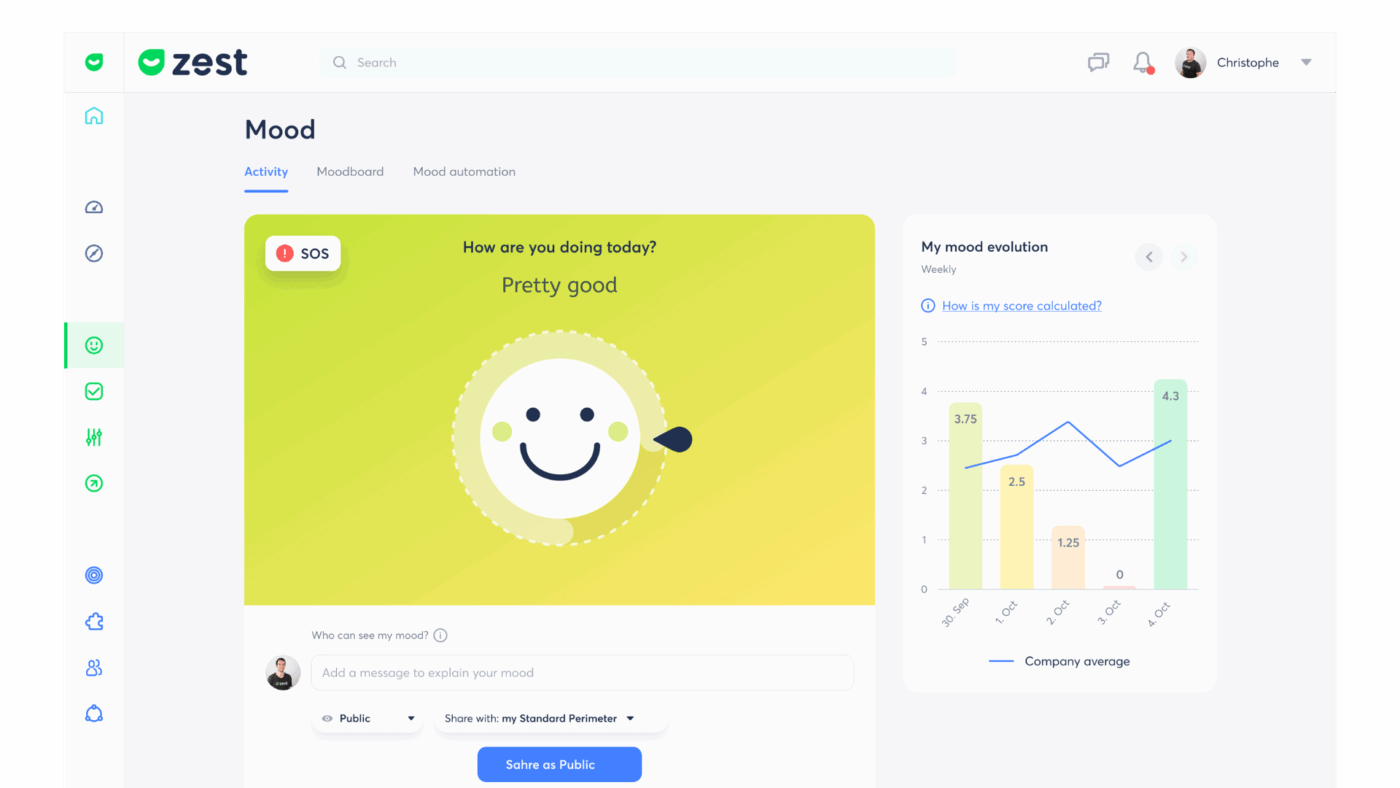
360° feedback: unleash and energize exchanges
Conduct regular check‑ins with your teams to quickly spot pain points.
Ideally, measure the evolution of their sentiments over time to see if it’s trending positively or negatively and to confirm that your actions are making an impact.
Encourage members from different teams to collaborate on common goals.
Feedback benefits HR teams, managers, and all employees by sharing useful tips and facilitating peer learning.
Invite your people to share feedback and ideas to boost collective intelligence and organizational resilience.
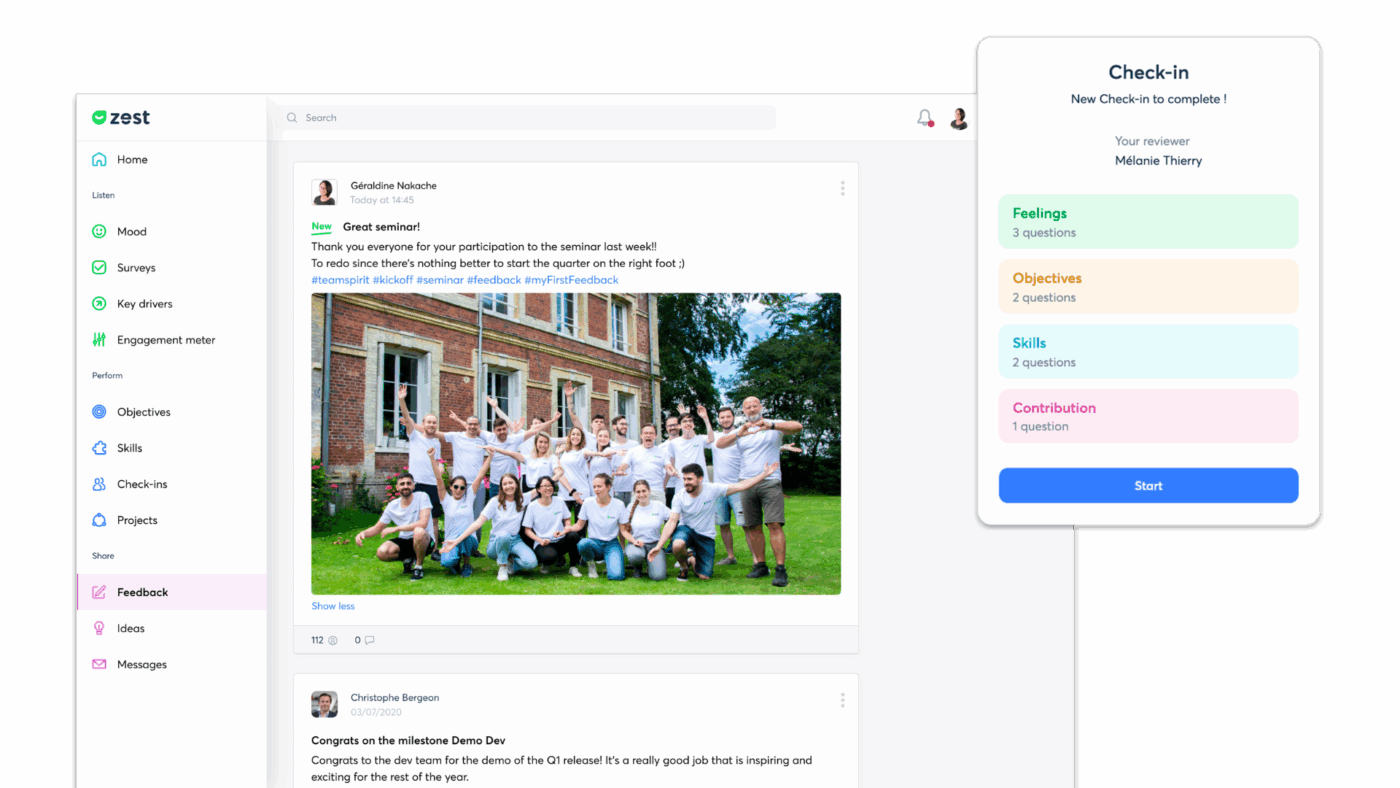
Streamline communication
Finally, recognize your employees. Encourage them to showcase their successes and highlights.
Don’t hesitate to thank and congratulate them, and prompt peer‑to‑peer recognition.
Above all, foster an environment of trust and psychological safety within your teams.
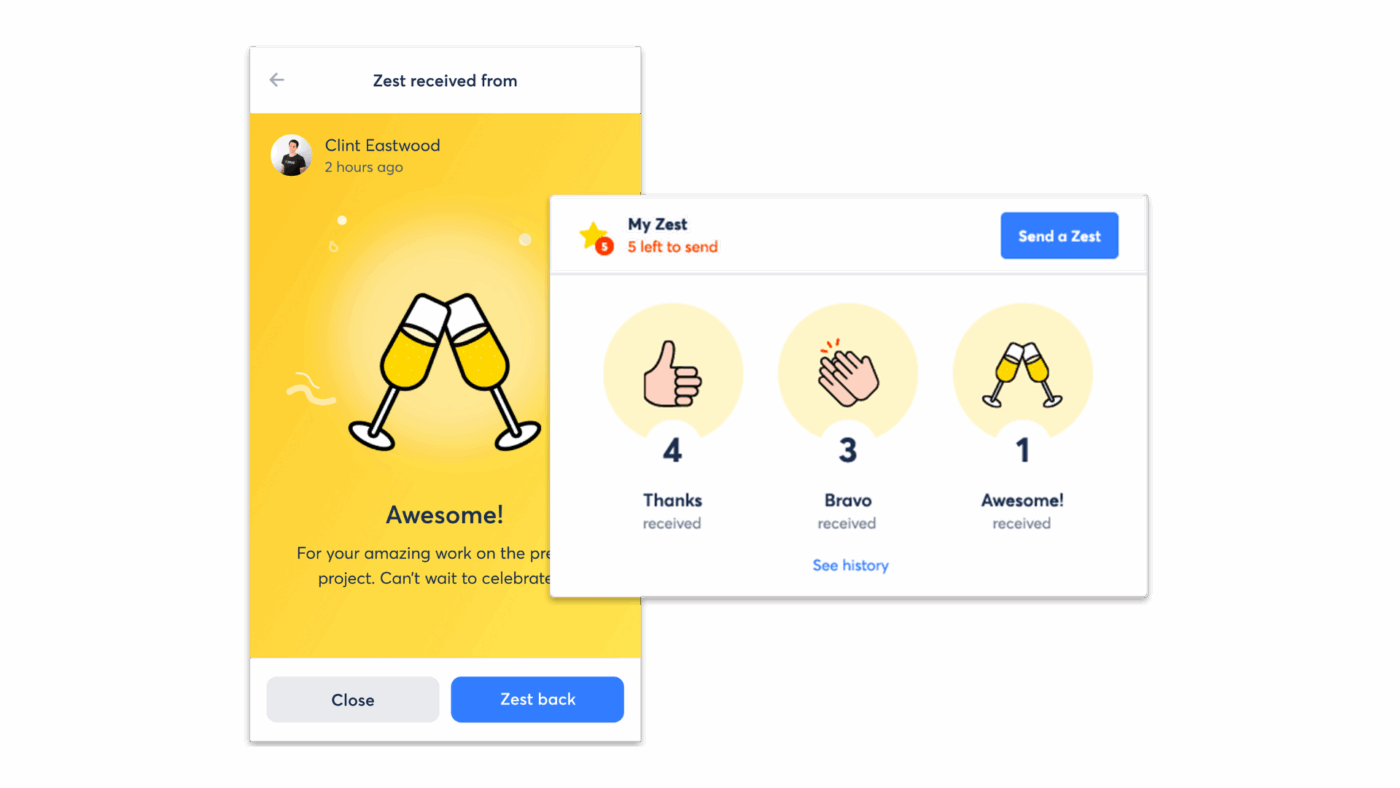
360° feedback method: what elements to evaluate?
During a 360° feedback process, multiple elements can be evaluated. Evaluation areas vary based on the specific needs of the organization and the employee’s role. Commonly assessed aspects include:

Technical skills
We evaluate job-specific knowledge and skills, including technical and specialized competencies as well as domain expertise.

Interpersonal skills
We assess the employee’s interpersonal competencies in how they engage with colleagues across the organization. This includes communication, collaboration, conflict management, active listening, and the ability to work effectively in teams.

Leadership
If the employee occupies a management or leadership role, evaluate their leadership style, decision‑making ability, skill at motivating teams, delegation effectiveness, and capacity to inspire and influence others.

Problem-solving
We assess the employee’s ability to identify, analyze, and resolve the challenges that arise in their work. This can include creativity, decision making, adaptability, pursuit of innovative solutions, and individual resilience.

Customer orientation
We evaluate customer-facing employees on their ability to understand client needs, deliver high-quality service, handle complaints, and build positive relationships.

Time and priority management
We assess the individual’s ability to manage their time effectively, prioritize tasks, meet deadlines, and stay organized in their work.

Professional development
we assess the employee’s commitment to personal and professional growth, including their willingness to learn, pursuit of new skills, participation in training, and adaptability to change.
it’s important to note that the elements evaluated can vary depending on the organization’s needs and objectives. 360° feedback captures multiple facets of an employee’s performance and delivers a comprehensive, diversified view of their competencies and behaviors.
360° feedback objectives for managers
 Engage and establish a feedback culture
Engage and establish a feedback culture
Most employees report they don’t receive regular feedback or recognition from their managers or colleagues. For 98% of them, this has a significant negative impact on motivation. Additionally, managers rarely have the insights needed to effectively support their teams on a daily basis.
 Gain an objective view of individual performance
Gain an objective view of individual performance
360° feedback provides your managers with multiple approaches and solutions to quickly identify employees who are struggling or disengaged. zest modernizes managerial practices by placing 360° feedback at the core of managers’ daily activities, empowering them to have an impact that’s as rewarding as it is effective.
 Define tailored HR action plans
Define tailored HR action plans
Personalized action plans can then be developed with a particular focus on cultivating individual skills and talent.
What are the benefits of 360° feedback?
 Multi-source feedback
Multi-source feedback
360° feedback offers several advantages over single‑source evaluations. It also gives individuals a unique opportunity to self‑assess. It is a constructive and collaborative process that gathers feedback from everyone an employee interacts with in their work ecosystem. The goal is to gain a more complete view of performance, identify strengths, weaknesses, and development areas through multiple perspectives. This assessment requires empathy and objectivity to contribute to organizational performance.
 Personal development
Personal development
360° feedback also gives employees a detailed view of their performance, enabling them to grow, develop, and gain concrete awareness of their skills, strengths, and gaps (self‑assessment objective). It can help them craft a personal development plan and pinpoint specific areas for improvement.
 Enhanced relationships
Enhanced relationships
By gathering feedback from colleagues and other stakeholders, 360° feedback fosters a deeper understanding of interactions and relationships within the organization. it can help address communication issues, strengthen collaboration, and promote a more harmonious work environment.
 Career decision making
Career decision making
360° feedback results can be used to make more informed decisions on promotions, compensation, career development, and recruitment. They can also help identify training needs by providing an objective, multi‑source evaluation of employee performance.
To sum up: a virtuous and sustainable cycle
For the evaluated individual: Transparent feedback on their work, their impact on others and the company, a clear assessment of key competencies and soft skills to develop, opportunities to steer their career (anticipate a role change, work on cross‑functional projects), and a strengthened sense of belonging and purpose.
For the team: Enhanced dialogue through anonymous surveys, a more collaborative work atmosphere, and a shared mindset of resilience.
For the organization: Identification of individual and collective strengths to leverage, confirmation of alignment with company values, expectations, and vision (work quality, attitude, set objectives), increased employee productivity, optimized training budgets, detection of high potentials, and improved communication.
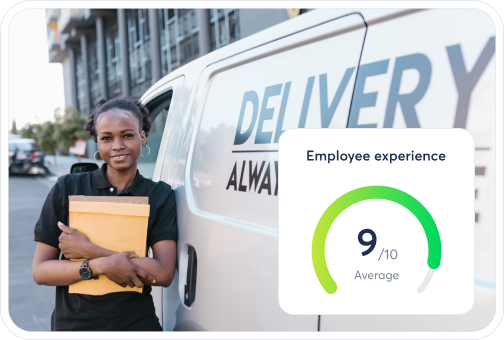
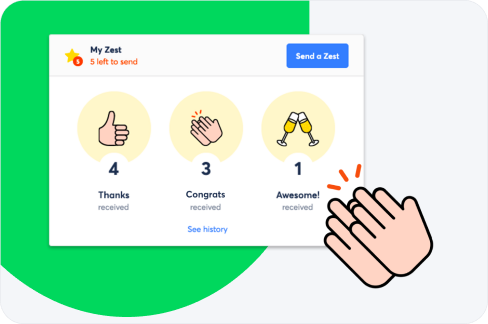
360° feedback: who evaluates the employee?
During a 360° feedback process, participants are evaluated by:
- Themselves (self‑assessment): in 87% of cases to compare their results with others and gain a comprehensive view of their soft skills at work (team cohesion, communication, leadership, managerial qualities, etc.)
- Their supervisors: in 90% of cases
- Their peers: in 87% of cases
- Their subordinates: when they hold a managerial role
- Sometimes even clients and/or suppliers: in 35% of cases (Healy et al., 2003 study)
10 tips for a successful 360° feedback
- Define the 360° feedback topics
- Set clear objectives
- Ensure the organization and participants are ready for the assessment
- Develop the 360° questionnaire
- Prepare the organization
- Mobilize teams to conduct the 360° feedback
- Conduct the 360° feedback assessment
- Record, analyze and share the results
- Define a personalized action plan to act effectively in the short, medium and long term
- Communicate on actions taken and schedule a process review
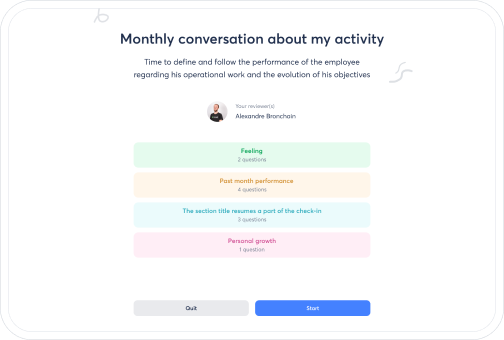
Company culture: why invest in 360° feedback?
Healey et al. (2003) found that over 70 % of surveyed organizations consider their 360° assessments to have been successful. Moreover, Derayeh and Brutus (2003) report that the majority of organizations implementing this process have achieved substantial organizational transformations since its introduction.
Zest enables regular recognition and sharing of feedback and ideas through 360° feedback. These dynamic, continuous exchanges engage employees, boost team cohesion, innovation, motivation, communication, and trust.
They also meet individuals’ needs for meaning, recognition, belonging, and learning. Employees become actively involved in projects and strategies and contribute directly to the company’s overall performance.
Disadvantages of 360° feedback
 Complex logistics and coordination
Complex logistics and coordination
Coordinating a non‑digital 360° feedback process is time‑consuming and complex.
 Risk of bias and lack of objectivity
Risk of bias and lack of objectivity
Without the anonymity guaranteed by digital tools, feedback can lack objectivity.
 Analysis and interpretation challenges
Analysis and interpretation challenges
Manual analysis of feedback is time-consuming and prone to errors.
 Ineffective follow-up
Ineffective follow-up
Without digital tools, tracking improvement actions is more challenging.
FAQ
Do you have any questions?
In a 360° feedback setting based on mutual evaluation, assessing your manager can feel delicate. However, it can be done constructively and professionally. Here are a few key steps to follow:
1. Understand the evaluation criteria: Get familiar with the criteria defined for the 360° process. These may include leadership, communication, and management skills.
2. Clarify what is expected and being assessed: Observe your manager’s behaviors, decisions, and actions over time. Collect specific examples that reflect their approach and impact.
3. Identify concrete examples: Select real-life situations that highlight your manager’s strengths, weaknesses, and how they influence your work. This will help make your feedback clear and grounded.
4. Stay objective: Aim for balanced feedback. Acknowledge strengths as well as areas for improvement, always backing your points with examples.
5. Remain professional and constructive: Express feedback respectfully, without personal judgment or unfounded criticism. Focus on the impact of your manager’s actions and suggest solutions.
6. Use clear and precise language: Avoid vague or general comments. The more specific your feedback, the more useful it will be for their development.
7. Offer improvement suggestions:
Don’t stop at pointing out weaknesses. Recommend actionable steps and areas for growth that could benefit both the manager and the team.
8. Respect confidentiality: Keep the process private. Do not discuss or share feedback with others, including your manager’s evaluation, outside of the intended process.
This kind of feedback, when done with care, supports a culture of trust, development, and continuous improvement.
Giving effective feedback means providing clear, constructive, and specific comments. Here are some tips for delivering high-quality feedback:
1. Be specific and constructive: Go into detail and suggest concrete, actionable improvements. Back up your comments with clear, specific examples. Avoid generalities and vague statements. The more precise your examples, the more helpful they’ll be to the person receiving the feedback.
2. Be objective and keep it concise:
Focus on facts and observable behaviors rather than personal opinions. Avoid value judgments and non-constructive criticism. The goal is to be direct and clear.
3. Balance strengths and weaknesses:
Don’t focus solely on areas for improvement. Also highlight the person’s strengths and successes. Balanced feedback offers a well-rounded view and supports development.
4. empathetic and respectful:
Take the person’s feelings into account when giving feedback. Adopt an empathetic and respectful tone to avoid coming across as offensive or discouraging. Feedback should be given in a spirit of openness, active listening, respect, and understanding. The goal is not to hurt but to help the person grow.
5. Give feedback at the right time:
Feedback is most effective when delivered promptly after the event or situation. Don’t wait too long between the observation and the feedback.
6. Encourage two-way communication:
Invite the person to share their thoughts and perspective on the feedback you’ve given. Encourage open discussion and clarification if needed.
7. Be open to dialogue:
Be ready to answer questions or clarify points. Feedback is an interactive process, and maintaining open communication is key to mutual understanding.
Building a 360° feedback questionnaire in a human resources (HR) evaluation context is a key step in collecting complete and relevant feedback.
1. Define the objectives: Before you begin designing the questionnaire, clarify the objectives of the 360° feedback. What specific aspects of skills and behaviors do you want to evaluate? What are the expected outcomes? This step will help guide the construction of the questionnaire.
2. Identify the dimensions to assess: Determine the key dimensions you want to evaluate. These may include technical, interpersonal, or leadership skills. Be sure to select dimensions that are relevant and aligned with the needs of the organization and the employees being evaluated.
3. Select the appropriate evaluators: Identify the appropriate groups of evaluators for each dimension. These may include direct supervisors, peers, subordinates, internal or external clients, and even the employee’s self-assessment. Each group can offer a different perspective on the skills and behaviors being evaluated.
4. Design specific questions: For each dimension, develop specific and clear questions that allow evaluators to provide accurate feedback. Use simple wording, avoid ambiguous terms, and ensure the questions are easy for everyone to understand.
5. Use a suitable rating scale: Choose an appropriate rating scale for each question. Common scales range from 1 to 5, 1 to 7, or even 1 to 10. Make sure the chosen scale reflects nuances and differences in performance.
It’s essential to establish clear processes and guidelines to ensure the confidentiality and anonymity of 360° evaluations. This creates an open and honest environment where employees feel comfortable providing constructive feedback.
Anonymized feedback from multiple sources also lends credibility to the insights raised, making them more impactful and actionable.
More Zest news

Mastering the professional development interview: key strategies and best practices

fixed-term contracts and annual reviews: 5 keys to a successful evaluation










